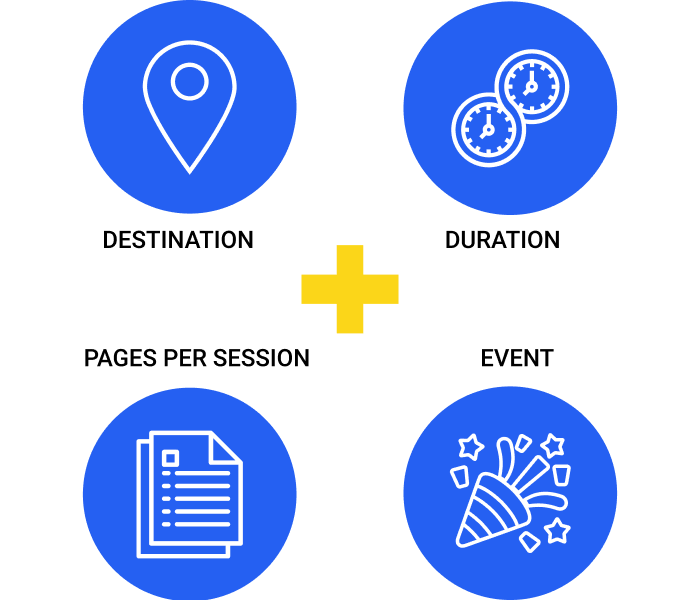Complete Guide To
Implementing Google Tag Manager first requires you to get your site in order. Let’s go back to our messy closet analogy for a second. The first task in getting organized is taking stock of what you have and what you need. Going through your closet before organizing it lets you spot clothes that are outdated, unnecessary, or no longer functional. Think holey boxer shorts, ratty Jnco pants from ’97, or the pink Abercrombie polo with the collar permanently popped.

Chapter 3 will show you how to whip your closet into organization-ready shape. You’ll find everything you’ll need to do to your site to deploy GTM without a hitch. We’ll explain how to set tracking requirements and goals, audit your tags, map out your site, and migrate and deploy tags. After reading this chapter, you’ll understand the importance of a well-planned development phase and know how to make it happen.
The first step is figuring out what data you want to gather. Do you have the tags in place to collect that information, or will you need to add more? The platform you’re currently using will also influence your tracking requirements.
Those of you already using Google platforms such as Google Analytics should have a pretty straightforward migration. On the other hand, if you’re migrating from a non-Google platform, you’ll need to do a little more planning. Data loss is a bigger risk for you, so be sure to consult Chapter 11 for risk management tips.
The goals in Google Analytics (GA) are one of marketers’ most potent tools. These goals tell you how well your site or mobile app’s performance aligns with your business objectives. Look over the following four categories of goals to start thinking about what you want GTM to monitor on your site.

> Destination – Lets GA know that a goal has been completed when a visitor reaches a certain page. For example, setting a destination goal with the URL to your “thank you” page will let you know what percentage of visits result in a transaction. In marketing speak, that’s a conversion rate.
> Duration – Measures how long a user spends on your site. These values are especially useful to measure engagement.
> Pages or screens per session – Triggered when visitors view a specified number of pages on your site or screens on your mobile app.
> Event – Triggered when any event you specify occurs in GA. Event goals give you an alternative perspective on site engagement. They let you track users who don’t convert in the traditional sense but still interact with your site in some meaningful way. For example, event goals let you track interactions like page printing, watching videos, or sharing your site on LinkedIn.

A tag audit will tell you what tags you have, where they are, how they’re firing (if at all), what their purposes are, and where they’re missing. You’ll need to document this information for each deployed tag, preferably in an Excel spreadsheet.
For websites more complex than a few pages, manually auditing tags can be a nightmare. If mind-numbing tasks aren’t your thing, consider using Google’s Tag Assistant or a 3rd-party tool called Tag Inspector. Tag Inspector has a crawler that is smart enough to fly under the radar of your analytics tools. Because the crawler goes undetected during the audit, its presence won’t corrupt your data.
Tag Inspector will then give you a tag hierarchy report of its findings. You’ll have a big-picture view of your tag pyramid, whether the tags are in the page’s source or piggy-backing on another tag. In other words, with Tag Inspector, tags can run but they can’t hide.
So you’ve channeled your inner Eminem and are now done cleanin’ out your metaphorical closet. The good news is that a solid tag audit is half the battle to mapping your website, the next step in the process. The tag audit provides a site template that will help you de-implement tags – or take down individual tags – and implement Google Tag Manager.
Before implementation, though, you’ll need to map your site out to verify that you have the right tags on the right pages. A site map ensures you’re collecting the highest-quality data. When mapping your site, make sure both development and measurement teams are involved. The analytics folks should have as much input here as the IT brainiacs.
To map out your site, you’ll need to ask three questions:
1.1. What data do you want to collect?
1.2. What events or user activities do you want to track?
1.3. Which vendors do you want to use to track that information?

Tag migration might sound like a documentary you’d see on Animal Planet, but we promise it’s much more digestible than that. Tag migration is the process of moving your site’s existing, or hard-coded, tags into Google Tag Manager. We’ll explain this process in detail in Chapter 7. For now, we’ll just explain what you can do to get ready for the final migration.
How difficult tag migration will be for you will depend on the complexity and size of your site as well as your technical expertise. These factors will help you assess your level of risk in moving your tags to GTM. Anytime you move to a tag management system, you face a risk that something will go wrong. To minimize the damage to your site, you should know how to debug the installation of Tag Manager and/or revert back to the last working version of your site if the implementation does go off the rails.

If you’re less than confident in your team’s ability to handle this, you might consider outsourcing tag migration and deployment to a third party (get in touch). In making that decision, consider these variables:
> Site complexity and size – If your site has thousands of pages, various desktop and mobile versions, several subdomains in different languages, mobile apps, and/or is handled by teams that are geographically dispersed, the migration to GTM could take months.
> Tracking complexity – If your site has many different configuration settings based on Google Analytics (e.g., from video tracking, cross-domain tracking, etc.) in addition to other analytics tools (e.g., IBM Digital Analytics, Adobe SiteCatalyst, etc.), migration will be complex even if your site is not very large.
Tag deployment planning requires you to map out the order in which you will import individual tags into Google Tag Manager to avoid technical problems or data gaps. In figuring out that sequence, you’ll have to identify the interconnected tags. That means you need to know when one tag’s output is another tag’s input. You’ll have to deploy these dependent tags simultaneously to prevent issues.
Now is also the time to decide whether you will do a partial or complete tag migration. The difference between the two is just as it sounds – a complete migration imports all your tags into GTM, whereas a partial migration imports only select tags. Some sites can only do a partial migration because of their size or tracking complexity.
However, Google strongly recommends a full migration because of the risk of double-tagging during deployment. Double-tagging happens when tags migrated to GTM remain hard-coded on your site or when you deploy the same tags through other tag management systems. Double-tagging will hurt your data’s integrity by either artificially inflating your numbers or making the collection process unreliable. The best way to avoid this is to remove your hard-coded tags immediately upon deploying them in GTM.
Part of Google Tag Manager’s beauty is that it is “easy and self-service,” to put it in Google’s words. Obviously, Google is a little biased on this one, but it’s correct. The purpose of GTM is to liberate marketing and metrics from their dependence on IT. The transition to GTM is the most challenging part of the process, which is why the development phase is so important.

If your migration is well-planned and well-executed, adding or modifying tags in the future will be a breeze. The development phase is the blueprint for GTM’s infrastructure. Once that’s in place, managing tags will be no more difficult than operating the office copy machine … maybe even simpler … definitely simpler.
As far as training goes, your IT department can probably tell you all you need to know. You can also supplement their instruction with Google’s amazingly thorough GTM help center. For highly complex needs, Google also has a page of Google Analytics Certified Partners who offer paid support and training in GTM. Or you can reach out to us!
Implementing Google Tag Manager first requires you to get your site in order. Let’s go back to our messy closet analogy for a second. The first task in getting organized is taking stock of what you have and what you need. Going through your closet before organizing it lets you spot clothes that are outdated, unnecessary, or no longer functional. Think holey boxer shorts, ratty Jnco pants from ’97, or the pink Abercrombie polo with the collar permanently popped.

Chapter 3 will show you how to whip your closet into organization-ready shape. You’ll find everything you’ll need to do to your site to deploy GTM without a hitch. We’ll explain how to set tracking requirements and goals, audit your tags, map out your site, and migrate and deploy tags. After reading this chapter, you’ll understand the importance of a well-planned development phase and know how to make it happen.
The first step is figuring out what data you want to gather. Do you have the tags in place to collect that information, or will you need to add more? The platform you’re currently using will also influence your tracking requirements.
Those of you already using Google platforms such as Google Analytics should have a pretty straightforward migration. On the other hand, if you’re migrating from a non-Google platform, you’ll need to do a little more planning. Data loss is a bigger risk for you, so be sure to consult Chapter 11 for risk management tips.
The goals in Google Analytics (GA) are one of marketers’ most potent tools. These goals tell you how well your site or mobile app’s performance aligns with your business objectives. Look over the following four categories of goals to start thinking about what you want GTM to monitor on your site.

> Destination – Lets GA know that a goal has been completed when a visitor reaches a certain page. For example, setting a destination goal with the URL to your “thank you” page will let you know what percentage of visits result in a transaction. In marketing speak, that’s a conversion rate.
> Duration – Measures how long a user spends on your site. These values are especially useful to measure engagement.
> Pages or screens per session – Triggered when visitors view a specified number of pages on your site or screens on your mobile app.
> Event – Triggered when any event you specify occurs in GA. Event goals give you an alternative perspective on site engagement. They let you track users who don’t convert in the traditional sense but still interact with your site in some meaningful way. For example, event goals let you track interactions like page printing, watching videos, or sharing your site on LinkedIn.

A tag audit will tell you what tags you have, where they are, how they’re firing (if at all), what their purposes are, and where they’re missing. You’ll need to document this information for each deployed tag, preferably in an Excel spreadsheet.
For websites more complex than a few pages, manually auditing tags can be a nightmare. If mind-numbing tasks aren’t your thing, consider using Google’s Tag Assistant or a 3rd-party tool called Tag Inspector. Tag Inspector has a crawler that is smart enough to fly under the radar of your analytics tools. Because the crawler goes undetected during the audit, its presence won’t corrupt your data.
Tag Inspector will then give you a tag hierarchy report of its findings. You’ll have a big-picture view of your tag pyramid, whether the tags are in the page’s source or piggy-backing on another tag. In other words, with Tag Inspector, tags can run but they can’t hide.
So you’ve channeled your inner Eminem and are now done cleanin’ out your metaphorical closet. The good news is that a solid tag audit is half the battle to mapping your website, the next step in the process. The tag audit provides a site template that will help you de-implement tags – or take down individual tags – and implement Google Tag Manager.
Before implementation, though, you’ll need to map your site out to verify that you have the right tags on the right pages. A site map ensures you’re collecting the highest-quality data. When mapping your site, make sure both development and measurement teams are involved. The analytics folks should have as much input here as the IT brainiacs.
To map out your site, you’ll need to ask three questions:
1.1. What data do you want to collect?
1.2. What events or user activities do you want to track?
1.3. Which vendors do you want to use to track that information?

Tag migration might sound like a documentary you’d see on Animal Planet, but we promise it’s much more digestible than that. Tag migration is the process of moving your site’s existing, or hard-coded, tags into Google Tag Manager. We’ll explain this process in detail in Chapter 7. For now, we’ll just explain what you can do to get ready for the final migration.
How difficult tag migration will be for you will depend on the complexity and size of your site as well as your technical expertise. These factors will help you assess your level of risk in moving your tags to GTM. Anytime you move to a tag management system, you face a risk that something will go wrong. To minimize the damage to your site, you should know how to debug the installation of Tag Manager and/or revert back to the last working version of your site if the implementation does go off the rails.

If you’re less than confident in your team’s ability to handle this, you might consider outsourcing tag migration and deployment to a third party (get in touch). In making that decision, consider these variables:
> Site complexity and size – If your site has thousands of pages, various desktop and mobile versions, several subdomains in different languages, mobile apps, and/or is handled by teams that are geographically dispersed, the migration to GTM could take months.
> Tracking complexity – If your site has many different configuration settings based on Google Analytics (e.g., from video tracking, cross-domain tracking, etc.) in addition to other analytics tools (e.g., IBM Digital Analytics, Adobe SiteCatalyst, etc.), migration will be complex even if your site is not very large.
Tag deployment planning requires you to map out the order in which you will import individual tags into Google Tag Manager to avoid technical problems or data gaps. In figuring out that sequence, you’ll have to identify the interconnected tags. That means you need to know when one tag’s output is another tag’s input. You’ll have to deploy these dependent tags simultaneously to prevent issues.
Now is also the time to decide whether you will do a partial or complete tag migration. The difference between the two is just as it sounds – a complete migration imports all your tags into GTM, whereas a partial migration imports only select tags. Some sites can only do a partial migration because of their size or tracking complexity.
However, Google strongly recommends a full migration because of the risk of double-tagging during deployment. Double-tagging happens when tags migrated to GTM remain hard-coded on your site or when you deploy the same tags through other tag management systems. Double-tagging will hurt your data’s integrity by either artificially inflating your numbers or making the collection process unreliable. The best way to avoid this is to remove your hard-coded tags immediately upon deploying them in GTM.
Part of Google Tag Manager’s beauty is that it is “easy and self-service,” to put it in Google’s words. Obviously, Google is a little biased on this one, but it’s correct. The purpose of GTM is to liberate marketing and metrics from their dependence on IT. The transition to GTM is the most challenging part of the process, which is why the development phase is so important.

If your migration is well-planned and well-executed, adding or modifying tags in the future will be a breeze. The development phase is the blueprint for GTM’s infrastructure. Once that’s in place, managing tags will be no more difficult than operating the office copy machine … maybe even simpler … definitely simpler.
As far as training goes, your IT department can probably tell you all you need to know. You can also supplement their instruction with Google’s amazingly thorough GTM help center. For highly complex needs, Google also has a page of Google Analytics Certified Partners who offer paid support and training in GTM. Or you can reach out to us!